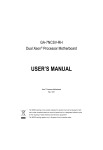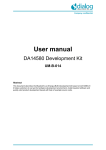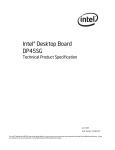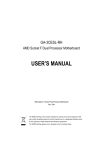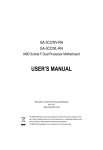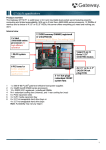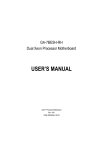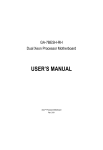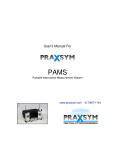Download USER`S Manual
Transcript
GA-7TEWH Dual Xeon Processor Motherboard USER’S Manual Xeon® Processor Motherboard Rev. 1001 * The WEEE marking on the product indicates this product must not be disposed of with user's other household waste and must be handed over to a designated collection point for the recycling of waste electrical and electronic equipment!! * The WEEE marking applies only in European Union's member states. Table of Contents Item Checklist ........................................................................................ 4 Chapter 1 Introduction ............................................................................ 5 1.1. Considerations Prior to Installation ...................................................... 5 1.2. Features Summary ............................................................................... 6 1.3. GA-7TEWH Motherboard Component ................................................ 8 Chapter 2 Hardware Installation Process ............................................. 11 2.1.Installing Processor and CPU Haet Sink ............................................ 11 2.1.1. Installing CPU ........................................................................................................ 11 2.1.2. Installing Heat Sink ............................................................................................... 12 2.2. Installing memory modules ................................................................ 13 2.3. Connect ribbon cables, cabinet wires, and power supply ................. 17 2.3.1. I/O Back Panel Introduction ................................................................................. 17 2.4. Connectors Introduction ..................................................................... 20 2.5. Jumper Setting .................................................................................... 29 Chapter 3 BIOS Setup ......................................................................... 31 Main ........................................................................................................... 33 Advanced ................................................................................................... 34 Processor Configuration .................................................................................................. 35 Power Management ........................................................................................................ 39 Memory Configuration ..................................................................................................... 42 Advanced Chipset Configuration ................................................................................... 44 PCI Configuration ............................................................................................................. 48 SATA Configuration .......................................................................................................... 50 I/O DeviceConfiguration .................................................................................................. 52 Boot DeviceConfiguration ................................................................................................ 54 Haradware Monitor .......................................................................................................... 56 Power ......................................................................................................... 57 Security ...................................................................................................... 59 Server ......................................................................................................... 61 2 English Table of Content English GA-7TEWH Motherboard System Management ...................................................................................................... 62 Console Redirection ........................................................................................................ 63 Boot ............................................................................................................ 65 Exit ............................................................................................................. 66 3 Introduction Item Checklist The GA-7TEWH motherboard Serial ATA cable x 6 I/O Shield Kit CD for motherboard driver & utility GA-7TEWH quick reference guide * The items listed above are for reference only, and are subject to change without notice. 4 English GA-7TEWH Motherboard Chapter 1 Introduction 1.1. Considerations Prior to Installation Preparing Your Computer The motherboard contains numerous delicate electronic circuits and components which can become damaged as a result of electrostatic discharge (ESD). Thus, prior to installation, please follow the instructions below: 1. Please turn off the computer and unplug its power cord. 2. When handling the motherboard, avoid touching any metal leads or connectors. 3. It is best to wear an electrostatic discharge (ESD) cuff when handling electronic components (CPU, RAM). 4. Prior to installing the electronic components, please have these items on top of an antistatic pad or within a electrostatic shielding container. 5. Please verify that the power supply is switched off before unplugging the power supply connector from the motherboard. Installation Notices 1. Prior to installation, please do not remove the stickers on the motherboard. These stickers are required for warranty validation. 2. Prior to the installation of the motherboard or any hardware, please first carefully read the information in the provided manual. 3. Before using the product, please verify that all cables and power connectors are connected. 4. To prevent damage to the motherboard, please do not allow screws to come in contact with the motherboard circuit or its components. 5. Please make sure there are no leftover screws or metal components placed on the motherboard or within the computer casing. 6. Please do not place the computer system on an uneven surface. 7. Turning on the computer power during the installation process can lead to damage to system components as well as physical harm to the user. 8. If you are uncertain about any installation steps or have a problem related to the use of the product, please consult a certified computer technician. Instances of Non-Warranty 1. 2. 3. 4. 5. 6. Damage due to natural disaster, accident or human cause. Damage as a result of violating the conditions recommended in the user manual. Damage due to improper installation. Damage due to use of uncertified components. Damage due to use exceeding the permitted parameters. Product determined to be an unofficial Gigabyte product. 5 Introduction 1.2. Features Summary Form Factor CPU 12” x 13” EATX size form factor, 8 layers PCB Supports Dual Intel® Xeon® Nehalem-EP 2S processors Xeon® Quad Core in LGA 1366 socket Supports QuickPath Interconnect up to 6.4GT/s Enhanced Intel SpeedStep Technology (EIST) & Demand Based Switch (DBS) Chipset Support Intel Virtualization Technology (VT) Intel® 5520 (Tylersburg-36D) Chipset Memory Intel® 82801JR (ICH10R) 12 x 1.5V DDR3 DIMM sockets supporting up to 96 GB of system memory 3 channel memory architecture Support 800/1066/1333 memory Support ECC RDIMM/ UDIMM ITE IT8720F Super I/O 1 PCI slots 32-Bit/33MHz (5V) 1 PCI-E x16 slot (Gen2 x16 bandwidth) 1 PCI-Express x8 slots (Gen2 at x8 bandwidth) 1 PCI-Express x8 slots (Gen2 at x4 bandwidth) 1 PCI-Express x8 slots (Gen 1 at x4 bandwidth) 1 SO-DIMM for add-on SAS RAID card (optional device) Intel® ICH10R SATA Controller Supports 6 independant SATA 3.0 Gb/s with Software RAID 0,1, 5,10 On-Board Audio IEEE1394A Realtek® ALC889A HD Audio Codec TI TSB43AB23 On-Board LAN Intel® 82567LM and 82574L GbE controllers support Gigabit Ethernet ports Supports QuickData DMA engine/TCP acceleration/IA-optimized TCP stack/DCA( Direct Cache Access)/LLI, MSI-X,RSS 2 x 8-pin ATX power connector 1 x 24-pin ATX power connector 6 x SATA 3.0Gb/s connectors 1 x Serial connector (COM) 1 x Audio connector 1 x IEEE 1394 connector I/O Control Expansion Slots SATA RAID Controller Internal Connector 6 English GA-7TEWH Motherboard Rear Panel I/O Hardware Monitor 1 x USB 2.0 connector for additional 2 ports by cable 1 x front panel connecctor 1 x PSMI connecctor 6 x System fan cable connector 2 x CPU fan cable connectors P/S 2 Keyboard and Mouse Connectors 1 x Serial port 1 x Parallel port supports Normal/EPP/ECP mode 1 x IEEE 1394 port 4 x USB 2.0 dual-port connector 2 x RJ45 LAN ports 6 x Audio ports (4 x Line-out/ 1 x Line-in/ 1 x MIC) Winbond 83792G controller Enhanced features with CPU Vcore, 1.5V reference, VCC3 (3.3V) , VBAT3V, +5VSB, CPUA/B Temperature, and System Temperature Values viewing CPU/Power/System Fan Revolution Detect CPU shutdown when overheat System Voltage Detect Support basic ASF remote transaction through CSA Bus with BIOS hardware circuit Phoenix BIOS on 16Mb flash RAM Additional Features Supports S4, S5 under Windows Operating System Wake on LAN (WOL) Wake on Ring (WOR) AC Recovery Supports Console Redirection Supports 4-pin Fan controller 7 Introduction 1.3. GA-7TEWH Motherboard Component No 1. 2. 3. 4. 5. 6. 7. 8. 9. 10. 11. 12. 13. 14. 15. 16. 17. 18. Code CPU1 CPU2 U82 U60 U188 U208 U207 AU1 U210 U34 COM2 F_1394 AUDIO_ACZ1 SPDIF_JP1 BAT CASE_OPEN F_PANEL1 PCI-E1 Description Primary CPU Secondary CPU Intel Tylersburg-36D IOH Intel ICH10R Winbond W83792G Intel 82567LM GbE Intel 82574L GbE Realtek ALC 889A TSB43AB23 1394 chipset BMC Flash ROM COM2 connector Front 1394 connector Front Audio connector SPDIF JP1 jumper CMOS battery Case open intrusion Front panel connector PCI-E x16 slo t(Gen2 at x16 bandwidth) 19. 20. PCI-E2 PCI-E3 PCI-E x8 slot (Gen2 at x8 bandwidth) PCI-E x8 slot (Gen2 at x4 bandwidth) 21. PCI-E4 PCI-E x8 slot (Gen1 at x4 bandwidth) 22. 23. 24. 25. 26. 27. 28. 29. 30. 31. 32. 33. 34. 35. 36. PCI5 PCIE_SODIM J3 SATA5 SATA4 SATA3 SATA2 SATA1 SATA0 USB1 SGPIO_ JP1 SGPIO_ JP2 PSMI FAN_CPU1 FAN_CPU2 PCI 32bit/33MHz slot SO-DIMM for SAS RAID card SMBus connector for B/P board SATA5 data cable connector SATA4 data cable connector SATA3 data cable connector SATA2 data cable connector SATA1 data cable connector SATA0 data cable connector Front USB connector SGPIO JP1 jumper SGPIO JP2 jumper SMBUS connector for power supply CPU1 fan cable connector CPU2 fan cable connector 8 English GA-7TEWH Motherboard No 37. 38. 39. 40. 41. 42. 43. 44. 45. 46. 47. 48. 49. 50. 51. 52. 53. 54. 55. 56. 57. 58. 59. 60. 61. 62. 63. 64. 65. 66. 67. 68. Code FAN_SYS6 FAN_SYS5 FAN_SYS4 FAN_SYS3 FAN_SYS2 FAN_SYS1 DIMMC1 DIMMC2 DIMMB1 DIMMB2 DIMMA1 DIMMA2 DIMMD2 DIMMD1 DIMME2 DIMME1 DIMMF2 DIMMF1 KB_MS COMA LPT1 1394_1 GLAN1 GLAN2 AUDIO1 ATX 12V_AUX2 12V_AUX1 CLR_CMOS CLR_RTC BIOS_RVCR PASS_DIS Description System fan 6 cable connector System fan 5 cable connector System fan 4 cable connector System fan 3 cable connector System fan 2 cable connector System fan 1 cable connector Channel C slot 1 (for primary CPU) Channel C slot 2 (for primary CPU) Channel B slot 1 (for primary CPU) Channel B slot 2 (for primary CPU) Channel A slot 1 (for primary CPU) Channel A slot 2 (for primary CPU) Channel D slot 2 (for secondary CPU) Channel D slot 1 (for secondary CPU) Channel E slot 2 (for secondary CPU) Channel E slot 1 (for secondary CPU) Channel F slot 2 (for secondary CPU) Channel F slot 1 (for secondary CPU) PS/2 Keyboard/Mouse ports Serial port Parallel port 1394a port Gigabit LAN port and USB ports Gigabit LAN port and USB ports Audio ports 24-pin Power connector CPU2 8-pin Power connector CPU1 8-pin Power connector Clear CMOS jumper Clear RTC jumper BIOS Recovery jumper Password Disable jumper 9 English GA-7TEWH Motherboard 14 13 12 9 15 16 17 22 21 20 59 58 57 56 55 19 5 38 18 37 35 63 66 67 68 25 26 6524 27 33 32 28 60 7 6 11 61 8 1 10 3 62 54 53 52 515049 29 30 4344 45464748 23 31 2 34 36 4 64 41 42 39 40 10 Hardware Installation Process Chapter 2 Hardware Installation Process 2.1. Installing Processor and CPU Haet Sink Before installing the processor and cooling fan, adhere to the following cautions: 1. The processor will overheat without the heatsink and/or fan, resulting in permanent irreparable damage. 2. Never force the processor into the socket. 3. Apply thermal grease on the processor before placing cooling fan. 4. Please make sure the CPU type is supported by the motherboard. 5. If you do not match the CPU socket Pin 1 and CPU cut edge well, it will cause improper installation. Please change the insert orientation. 2.1.1. Installing CPU Step 1 Raise the metal locking lever on the socket. Step 2 Remove the plastic covering on the CPU socket. Step 3 Insert the CPU with the correct orientation. The CPU only fits in one orientation. Step 4 Once the CPU is properly placed, please replace the metal cover and push the metal lever back into locked position. 11 English GA-7TEWH Motherboard 2.1.2. Installing Heat Sink Step 1 Attach the heat sink clip to the processor socket. Step 2 Secure the cooing fan with screws. Step 3 Connect processor fan can cable to the processor fanconnector 2 2 2 1 12 Hardware Installation Process 2.2. Installing memory modules Before installing the memory modules, please comply with the following conditions: 1. Please make sure that the memory is supported by the motherboard. It is recommended to use the memory with similar capacity, specifications and brand. 2. Before installing or removing memory modules, please make sure that the computer power is switched off to prevent hardware damage. 3. Memory modules have a foolproof insertion design. A memory module can be installed in only one direction. If you are unable to insert the module, please switch the direction. The motherboard supports DDR3 memory modules, whereby BIOS will automatically detect memory capacity and specifications. Memory modules are designed so that they can be inserted only in one direction. The memory capacity used can differ with each slot. Memory sockets for Processor 1 Memory sockets for Processor 2 13 Hardware Installation Process Installation Steps: Step 1. Insert the DIMM memory module vertically into the DIMM slot, and push it down. Step 2. Close the plastic clip at both edges of the DIMM slots to lock the DIMM module. NOTE! DIMM must be populated in order starting from DIMMA1/D1 socket. For dual-channel operation, DIMMs must be installed in matched pairs. Step 3. Reverse the installation steps when you wish to remove the DIMM module. 1 2 2 DIMMC1 DIMMB1 DIMMC2 DIMMB2 DIMMA1 DIMMA2 CPU1 CPU2 DIMMD2 DIMMD1 DIMME2 DIMME1 DIMMF2 DIMMF1 14 English GA-7TEWH Motherboard U-DIMM Population Table Interleave mode Single Channel Dual Channel Three Channel Channel A Channel B Channel C DIMMA1/D1 DIMMA2/D2 DIMMB1/E1 DIMMB2/E2 DIMMC1/F1 DIMMC2/F2 Total Memory 1GB 1GB 2GB 2GB 4GB 4GB 1GB 1GB 2GB 2GB 2GB 4GB 4GB 4GB 8GB 1GB 1GB 1GB 1GB 4GB 2GB 2GB 2GB 2GB 8GB 4GB 4GB 4GB 4GB 16GB 1GB 1GB 1GB 3GB 2GB 2GB 2GB 6GB 4GB 4GB 4GB 16GB 1GB 1GB 1GB 1GB 1GB 1GB 6GB 2GB 2GB 2GB 2GB 2GB 2GB 12GB 4GB 4GB 4GB 4GB 4GB 4GB 24GB 15 English GA-7TEWH Motherboard R-DIMM Population Table Interleave mode Single Channel Dual Channel Three Channel Channel A Channel B Channel C DIMMA1/D1 DIMMA2/D2 DIMMB1/E1 DIMMB2/E2 DIMMC1/F1 DIMMC2/F2 Total Memory 1GB 1GB 2GB 2GB 4GB 4GB 8GB 8GB 1GB 1GB 2GB 2GB 2GB 4GB 4GB 4GB 8GB 8GB 8GB 16GB 1GB 1GB 1GB 1GB 4GB 2GB 2GB 2GB 2GB 8GB 4GB 4GB 4GB 4GB 16GB 8GB 8GB 8GB 8GB 32GB 1GB 1GB 1GB 3GB 2GB 2GB 2GB 6GB 4GB 4GB 4GB 12GB 8GB 8GB 8GB 24GB 1GB 1GB 1GB 1GB 1GB 1GB 6GB 2GB 2GB 2GB 2GB 2GB 2GB 12GB 4GB 4GB 4GB 4GB 4GB 4GB 24GB 8GB 8GB 8GB 8GB 8GB 8GB 48GB 16 Hardware Installation Process 2.3. Connect ribbon cables, cabinet wires, and power supply 2.3.1. I/O Back Panel Introduction 17 English GA-7TEWH Motherboard PS/2 Keyboard and PS/2 Mouse Connector To install a PS/2 port keyboard and mouse, plug the mouse to the upper port (green) and the keyboard to the lower port (purple). Parallel Port / Serial Port This connector supports 1 standard 1 Parallel port. Device like printer can be connected to Parallel port. Serial Port Connects to serial-based mouse or data processing devices. IEEE1394 Port Serial interface standard set by Institute of Electrical and Electronics Engineers, which has features with high speed, high bandwidth and hot plug. Gigabit LAN Ports The LAN port provides Internet connection of Gigabit Ethernet with data transfer speeds of 10/100/1000Mbps. USB Port Before you connect your device(s) into USB connector(s), please make sure your device(s) such as USB keyboard, mouse, scanner, zip, speaker...etc. have a standard USB interface. Also make sure your OS supports USB controller. If your OS does not support USB controller, please contact OS vendor for possible patch or driver updated. For more information please contact your OS or device(s) vendors. Line In The default Line In jack. Devices like CD-ROM, walkman etc. can be connected to Line In jack. Line Out (Front Speaker Out) The default Line Out (Front Speaker Out) jack. Stereo speakers, earphone or front surround speakers can be connected to Line Out (Front Speaker Out) jack. MIC In The default MIC In jack. Microphone must be connected to MIC In jack. Surround Speaker Out (Rear Speaker Out) The default Surround Speaker Out (Rear Speaker Out) jack. Rear surround speakers can be connected to Surround Speaker Out (Rear Speaker Out) jack. Center/Subwoofer Speaker Out The default Center/Subwoofer Speaker Out jack. Center/Subwoofer speakers can be connected to Center/Subwoofer Speaker Out jack. 18 Hardware Installation Process Side Speaker Out The default Side Speaker Out jack. Surround side speakers can be connected to Side Speaker Out jack. LAN LED Description LED2 (Green/Yellow) LED1 (Green) Name Color Condition Description LED1 Green Green ON BLINK LAN Link / no Access LAN Access - OFF OFF Idle 10Mbps connection Green Green BLINK ON Port identification with 10 Mbps connection 100Mbps connection Green Yellow BLINK ON Port identification with 100Mbps connection 1Gbps connection Yellow BLINK Port identification with 1Gbps connection LED2 19 English GA-7TEWH Motherboard 2.4. Connectors Introduction 14 6 4 27 16 8 14 13 12 11 10 9 22 23 2 23 26 25 1 5 15 17 3 21 20 19 18 1. ATX 15. PSMI 2. 12V_AUX1 16. FAN_CPU1 (CPU1 fan cable connector) 3. 12V_AUX2 4. COM2 17. FAN_CPU2 (CPU2 fan cable connector) 18. SYS_FAN1 (System fan connector) 5. USB1 (Front USB cable connector) 6. F_1394 19. SYS_FAN2 (System fan connector) 20. SYS_FAN3 (System fan connector) 7. FAUDIO_ACZ 8. F_PANEL 21. SYS_FAN4 (System fan connector) 22. SYS_FAN5 (System fan connector) 9. SATA0 (SATA data cable connector) 10. SATA1 (SATA data cable connector) 23. SYS_FAN6 (System fan connector) 24. J3 11. SATA2 (SATA data cable connector) 12. SATA3 (SATA data cable connector) 25. SGPIO_JP1 26. SGPIO_JP12 13. SATA4 (SATA data cable connector 14. SATA5 (SATA data cable connector 27. BAT 20 English GA-7TEWH Motherboard 1/2/3 ) ATX/12V_AUX1/12V_AUX2 (24-pin/8-pin ATX power connectors) With the use of the power connector, the power supply can supply enough stable power to all the components on the motherboard. Before connecting the power connector, please make sure that all components and devices are properly installed. Align the power connector with its proper location on the motherboard and connect tightly. The ATX_12V power connector mainly supplies power to the CPU. If the ATX_12V power connector is not connected, the system will not start. Caution! Please use a power supply that is able to support the system voltage requirements. It is recommended that a power supply that can withstand high power consumption be used (350W or greater). If a power supply is used that does not provide the required power, the result can lead to an unstable system or a system that is unable to start. If you use a power supply that provides a 24-pin ATX power connector, please remove the small cover on the power connector on the motherboard before plugging in the power cord; otherwise, please do not remove it. 5 1 8 4 CPU0/DDR3 socket for CPU0 CPU1/DDR3 socket for CPU1 Pin No. 1 2 3 4 5 6 7 8 Definition GND GND GND GND P12V_DDR3_CPU0 P12V_DDR3_CPU0 P12V_CPU0 P12V_CPU0 21 Pin No. 1 2 3 4 5 6 7 8 Definition GND GND GND GND P12V_DDR3_CPU1 P12V_DDR3_CPU1 P12V_CPU1 P12V_CPU1 Connector Introduction 13 1 Pin No. Definition 1 2 3.3V 3.3V 3 4 GND +5V 5 6 GND +5V 7 8 GND Power Good 9 10 5V SB(stand by +5V) +12V 11 12 +12V(Only for 24-pin ATX) 3.3V(Only for 24-pin ATX) 12 24 22 Pin No. 13 Definition 3.3V 14 15 -12V GND 16 17 PS_ON(soft On/Off) GND 18 19 GND GND 20 21 -5V +5V 22 23 +5V +5V (Only for 24-pin ATX) 24 GND(Only for 24-pin ATX) English GA-7TEWH Motherboard 4 ) COM2 2 1 10 9 Pin No. 1 2 3 4 5 6 7 8 9 10 Definition DCDSIN2 SOUT2 DTR2GND DSR2RTS2CTS2RI2NC 5 ) USB1 (USB cable connector) Be careful with the polarity of the front USB connector. Check the pin assignment carefully while you connect the front USB cable, incorrect connection between the cable and connector will make the device unable to work or even damage it. For optional front USB cable, please contact your local dealer. Pin No. 1 2 9 10 23 Definition 1 2 5V power 5V power 3 4 -FUSB4 -FUSB5 5 6 +FUSB4 +FUSB5 7 8 GND GND 9 10 NC NC Connector Introduction 6 ) F_1394(IEEE 1394 connector) 12 9 10 Pin No. 1 2 3 4 5 6 7 8 9 10 Definition FTPA1+ FTPA1GND GND FTPB1+ FTPB1BUSVCC0 BUSVCC0 No Pin NC 7 ) FAUDIO_ACZ1 (Front AUDIO connector) In order to utilize the front audio header, your chassis must have front audio connector. Also please make sure the pin assigment on the cable is the same as the pin assigment on the MB header. To find out if the chassis you are buying support front audio connector, please contact your dealer. 10 9 21 24 Pin No. Definition 1 MIC 2 GND 3 REF 4 POWER 5 FrontAudio(R) 6 RearAudio(R) 7 Reserved 8 No Pin 9 FrontAudio (L) 10 RearAudio(L) English GA-7TEWH Motherboard 8 ) F_PANEL (2X12 Pins Front Panel connector) Please connect the power LED, PC speaker, reset switch and power switch of your chassis front panel to the F_PANEL connector according to the pin assignment above. 12 23 24 Pin No. 1. 2. 3. 4. 5. 6. 7. 8. 9. 10. 11. 12. 13. 14. 15. 16. 17. 18. 19. 20. 21. 22. 23. 24. Signal Name Power LED + 5V standby Pin reomoved ID LED+ Power LED ID LED HD status LED+ System ready LED+ HD status LEDSystem ready LEDPower on switch LAN1 active LED (-) GND LAN1 active LED (+) Reset switch SMBUS data GND SMBUS clock ID LED switch CASEOPEN GND LAN2 active LED (-) NMI switch LAN2 active LED (+) Description Power LED Signal anode (+) P5V Stand By Power Pin removed ID LED Signal anode (+) Power LED Signal cathode(-) ID LED Signal cathode(-) Hard Disk LED Signal anode (+) System Fan Fail LED Signal anode (+) Hard Disk LED Signal cathode(-) System Fan Fail LED Signal cathode(-) Power button LAN1 active LED Signal cathode(-) Ground LAN1 active LED Signal anode (+) Reset button Signal SMBusData Ground SMBusClock ID Switch Signal Chassis intrusion Signal Ground LAN2 active LED Signal cathode(-) NMI switch Signal LAN2 active LED Signal anode (+) 25 Connector Introduction 9/ 10/ 11/ 12/ 13/ 14 ) SATA 0~5 (Serial ATA cable connectors) SATA 3Gb/s can provide up to 300MB/s stransfer rate. Please refer to the BIOS setting for the SATA 3Gb/s and install the proper driver in order to work properly. 7 1 Pin No. 1 2 3 4 5 6 7 Definition GND TXP TXN GND RXN RXP GND 15 ) PSMI (SMBUS connector for power supply) 1 26 Pin No. 1 2 3 4 5 Definition SMBus Clock SMBUS Data SMBUS Alert GND 3.3V English GA-7TEWH Motherboard 16~23 ) FAN_CPU1/2 / SYS_FAN1/2/3/4/5/6 (CPU fan / System fan cable connectors) The cooler fan power connector supplies a +12V power voltage via a 3-pin/4-pin(CPU_FAN) power connector and possesses a foolproof connection design. Most coolers are designed with color-coded power connector wires. A red power connector wire indicates a positive connection and requires a +12V power voltage. The black connector wire is the ground wire (GND). Remember to connect the CPU/system fan cable to the CPU_FAN/SYS_FAN connector to prevent CPU damage or system hanging caused by overheating. SYS FAN5 FAN_CPU1 SYS FAN6 1 1 Pin No. 1 2 3 4 FAN_CPU2 SYS FAN4 Definition GND 12V Sense Control SYS FAN1 SYS FAN3 SYS FAN2 24 ) J3 (SMBus connector for B/P board) 1 Pin No. 1 2 3 4 27 Definition GND P5V_AUX R_SDA R_SCL English GA-7TEWH Motherboard 25/26 ) SGPIO_JP1/SGPIO_JP2 (ICH10 SGPIO connector) SGPIO is stands for Serial General Purpose Input/Output which is a 4-signal (or 4-wire) bus used between a Host Bus Adapter (HBA) and a backplane. Out of the 4 signals, 3 are driven by the HBA and 1 is driven by the backplane. Typically, the HBA is a storage controller located inside a server, desktop, rack or workstation computer that interfaces with Hard disk drives (HDDs) to store and retrieve data. SGPIO_JP1 SGPIO_JP2 1 Pin No. 1 2 3 4 5 Definition GND NC ICH_SATA_SDATA0 ICH_SATA_SLOAD ICH_SATA_SCLOCK SGPIOJP2 SGPIO_JP1 Pin No. 1 2 3 4 5 Definition GND NC ICH_SATA_SDATA1 ICH_SATA_SLOAD ICH_SATA_SCLOCK 27 ) BAT (Battery) If you want to erase CMOS... 1.Turn OFF the computer and unplug the power cord. 2.Remove the battery, wait for 30 second. 3.Re-install the battery. 4.Plug the power cord and turn ON the computer. CAUTION Danger of explosion if battery is incorrectly replaced. Replace only with the same or equivalent type recommended by the manufacturer. Dispose of used batteries according to the manufacturer’s instructions. 28 Jumper Setting 2.5. Jumper Setting 2 3 4 1 29 English GA-7TEWH Motherboard 1 ) CLR_CMOS (Clear CMOS jumper) You may clear the CMOS data to its default values by this jumper. Default value doesn’t include the “Shunter” to prevent from improper use this jumper. To clear CMOS, temporarily short 2-3 pin. 1 1-2 close: Normal operation (Default setting) 1 2-3 close: Clear CMOS 2 ) CLR_RTC (Clear RTC jumper) 1 1-2 close: Normal operation. (Default setting) 1 2-3 close: Clear RTC status 3 ) BIOS_RVCR (BIOS Revocery jumper) 1 1-2 close: Normal operation. (Default setting) 1 2-3 close: Enable BIOS Recovery function. 4 ) PASS_DIS (Skip Supervisor password jumper) 1 1-2 Close: Normal operation. (Default setting) 1 2-3 Close: Clear Supervisor Password in BIOS setup menu. 30 GA-7TEWH Motherboard Chapter 3 BIOS Setup BIOS (Basic Input and Output System) includes a CMOS SETUP utility which allows user to configure required settings or to activate certain system features. The CMOS SETUP saves the configuration in the CMOS SRAM of the motherboard. When the power is turned off, the battery on the motherboard supplies the necessary power to the CMOS SRAM. ENTERINGSETUP When the power is turned on, press the <F2> button during the BIOS POST (Power-On Self Test) will take you to the CMOS SETUP screen. You can enter the BIOS setup screen by pressing "Ctrl + F1". CONTROLKEYS <> Move to previous item <> Move to next item <> Move to the item in the left hand <> Move to the item in the right hand <Esc> Main Menu - Quit and not save changes into CMOS Status Page Setup Menu and Option Page Setup Menu - Exit current page and return to Main Menu <+/PgUp> Increase the numeric value or make changes <-/PgDn> Decrease the numeric value or make changes <F1> General help, only for Status Page Setup Menu and Option Page Setup Menu <F2> Reserved <F3> Reserved <F4> Reserved <F6> Reserved <F7> Reserved <F8> Reserved <F9> Load the Optimized Defaults <F10> Save all the CMOS changes, only for Main Menu 31 BIOS Setup GETTINGHELP Main Menu The on-line description of the highlighted setup function is displayed at the bottom of the screen. Status Page Setup Menu / Option Page Setup Menu Press F1 to pop up a small help window that describes the appropriate keys to use and the possible selections for the highlighted item. To exit the Help Window press <Esc>. Select the Load Setup Defaults item in the BIOS Exit Setup menu when somehow the system is not stable as usual. This action makes the system reset to the default settings for stability. Main This setup page includes all the items in standard compatible BIOS. Advanced This setup page includes all the items of Phoenix BIOS special enhanced features. (ex: Auto detect fan and temperature status, automatically configure hard disk parameters.) Power This setup page includes all the items of Green function features. Security Change, set, or disable password. It allows you to limit access the system and setup. Server Server additional features enabled/disabled setup menus. Boot This setup page include all the items of first boot function features. Exit There are five optionsin this selection: Exit Saving Changes, Exit Discarding Changes, Load Optimal Defaults, Load Failsafe Defaults, and Discard Changes. 32 GA-7TEWH Motherboard Main Once you enter Phoenix BIOS Setup Utility, the Main Menu (Figure 1) will appear on the screen. Use arrow keys to select among the items and press <Enter> to accept or enter the sub-menu. Figure 1: Main System Date Set the System Date. Note that the “Day” automatically changed after you set the date. System Time The time is calculated based on the 24-hour military time clock. Set the System Time (HH:MM:SS) CPU Type/CPU Speed/ CPU Count This category includes the information of CPU type, Speed ,and number of CPU count. Total Memory The BIOS determines how much total memory is present during the POST. 33 BIOS Setup Advanced About This Section: Advanced With this section, allowing user to configure your system for advanced operation. User can set the Processor configuration, Memory configuration, Advanced chipset control, PCI configuration , SATA configuration, I/O Device configuration, Boot configuration, and Hardware monitor. Figure 2: Advanced 34 GA-7TEWH Motherboard Processor Configuration 35 BIOS Setup Processor Configuration This category includes the information of CPU Speed, Processor ID ,Processor L2 / L3 Cache, and QPI Frequency. And setup sub-menu for CPU Power Management. Please note that setup menu options will be variable depends on the type of CPU. Multiprocessor Specification This option allows user to configure the multiprocessor(MP) specification revision level. Some operating system will require 1.1 for compatibility reasons. 1.4 Support MPS Version 1.4 . (Default setting) 1.1 Support M PS Version 1.1. Intel (R) Virtualization Technology Intel(R) Virtualization Technology will allow a platform to run multiple operating systems and applications in independent partitions. With virtualization, one computer system can function as multiple “virtual” systems. With processor and I/O enhancements to Intel’s various platforms, Intel Virtualization Technology can improve the performance and robustness of today’s softwareonly virtual machine solutions. 36 GA-7TEWH Motherboard Enabled Enable Intel Virtualization Technology. (Default setting) Disabled Disable this function. Execute Disable Bit Enabled Enable Execute Disable Bit. (Default setting) Disabled Disable this function. Hardware Prefetcher The Hardware Prefetcher looks the streams of data. The data is prefetched into L2 from external memory. Disabling of this item may impact processor performance. Enabled Enabled Hardware Prefetcher. (Default setting) Disabled Disables this function. Adjacent Cache Line Prefetch When enable this item, both cache lines that comprise a cache line pair when it determines data required is not currently in its cache. Enabled Adjacent Cache Line Prefetch. (Default setting) Disabled Disables this function. CPU Thermal Trip Enabled Enable CPU Thermal Trip. (Default setting) Disabled Disable CPU Thermal Trip. Processor Retest Enabled Enable Processor Retest. Disabled Disable Processor Retest. (Default setting) NUMAAware Enabled Enable NUMA Aware. (Default setting) Disabled Disable NUMA Aware. ACPI SRAT Report Enabled Enable ACPI SRAT Report. (Default setting) Disabled Disable ACPI SRAT Report. Active Processor Cores Options One Core, Two cores, Max Cores. Default setting is Max Cores. 37 BIOS Setup Hyper-Threading Technology Enabled Enable Intel Hyper Threading Technology. Disabled Disable Intel Hyper Threading Technology. (Default setting) A20M Support Enabled Enable A20M Support. (Default setting) Disabled Disable A20M Support. Machine Checking Enabled Enable Machine Checking. (Default setting) Disabled Disable Machine Checking. Discrete MTRR Allocation Enabled Enable Discrete MTRR Allocation. Disabled Disable Discrete MTRR Allocation. (Default setting) Thermal Management Enabled Enable Thermal Management. (Default setting) Disabled Disable Thermal Management. 38 GA-7TEWH Motherboard Power Management Figure 2-1-1: Power Management EIST (GV3) & C State Enabled Enable EIST (GV3) and C State items. (Default setting) Disabled Disable EIST (GV3) and C State items. EIST (GV3) Enabled Enable EIST (GV3. (Default setting) Disabled Disable EIST (GV3). EIST PSD Function HW_ALL In HW_ALL mode, the rpocessor hardware is responsible for coordinating the P-state among logical processors dependencies. The OS is responsible for keeping the P-state request up to date on all logical processors. (Default setting) 39 BIOS Setup SW_ALL In SW_ALL mode, the OS Power Manager is responsible for coordinating the P-state among loical processors with dependencies and must initiate the transition on all of those Logical Processors. SW_ANY In SW_ANY mode, the OS Power Manager is responsible for corrdinating the P-state among logical processors with dependencies and may initiate the transition on any of those Logical Processors . Turbo Mode Turbo Mode automatically allows processor cores to run faster than marked frequency if the physical processor is operating below power, temperature and current specification limits. Turbo Mode can be engaged with SMT (Simultanceous Multi Threading) enabled and 1 to 4 cores active and is not limited to only a single core or logical processor. Enabled Turbo Mode. (Default setting) Disabled Disable Turbo Mode. T State Enabled Enable CPU T-State. (Default setting) Disabled Disable T-State. CPU C State Enabled Enable ACPI C-State (C0, C1/C1E, C3, C6 and C7). (Default setting) Disabled Disable C-State. CPU C1E Enabled Enable CPU C1E. (Default setting) Disabled Disable CPU C1E. OS ACPI C3 Report C3 Desire state for the Nehalem core C3 state include in the CST as ACPI C3 state. C2 Desire state for the Nehalem core C2 state include in the CST as ACPI C2 state. Disabled Disable OS ACPI C3 Report. (Default setting) CPU C6 Report Enabled Desire state for the Nehalem core C6 state include in the CST as ACPI C3 40 GA-7TEWH Motherboard state. Disabled Disable CPU C6 Report. (Default setting) CPU C7 Report Enabled Desire state for the Nehalem core C7 state include in the CST as ACPI C3 state. (Default setting) Disabled Disable CPU C7 Report. Package C State Limit Desired state for the C-State package limit. Options C0, C1 State, C3 State, C6 State, C7 State, No Limit. The default setting is No Limit. ACPI MWAIT extensions Enabled CST using MWAIT extension isenabled for OSPM use. Disabled Disable ACPI MWAIT extensions. 41 BIOS Setup Memory Configuration 42 GA-7TEWH Motherboard Base Memory/Extended Memory/DIMM Status These category is display-only which is determined by POST (Power On Self Test) of the BIOS. Memory Reset Yes Select ‘Yes’, system will clear the memory error status. Save the changes and restart system. After rebooting system, the Memory Reset item will set to ‘No’ automatically. No No chnages. (Default setting) Memory Control Settings Manual Select ‘Manual” will pops up sub-menu for configuration. Auto Auto configuration. (Default setting) 43 BIOS Setup Advanced Chipset Configuration Figure 2-3: Advanced Chipset Configuration 44 GA-7TEWH Motherboard Figure 2-3-1: Intel VT for Directed I/O (VT-d) 45 BIOS Setup Intel VT for Directed I/O (VT-d) Interrupt Remapping Enabled Enable Interrupt Remapping. (Default setting) Disabled Disable Interrupt Remapping. Coherency Support Enabled Enable Coherency Support. Disabled Disable Coherency Support. (Default setting) ATS Enabled Enable ATS. (Default setting) Disabled Disable ATS. PassThrough DMA Enabled Enable PassThrough DMA. (Default setting) Disabled Disable PassThrough DMA. VT-d for Port1~Port 10 Enabled Enable VT-d support for Port 1~Port 10 ports through ATSR structures in ACPI Tables. (Default setting) Disabled Disable VT-d for Port1~Port 10. Advanced Chipset Control Main Menu Options Intel (R) I/OAT Enabled Enable configuration mapped accesses to the I/OAT configuration sapce. (Default setting) Disabled Disable I/OAT. IOH IOxAPIC Enabled Enable IOH IOxAPIC function (Default setting) Disabled Disable I/OAT. QPI Control Settings Enabled Enable QPI Control settings. (Default setting) Disabled QPI Control settings. QPI Link Fast Mode Enabled Enable QPI Link Fast Mode. (Default setting) Disabled Disable QPI Link Fast Mode. QPI Frequency Selection 46 GA-7TEWH Motherboard Identify the desire value of QPI frequency. Option available: Auto, 4.800GT, 5.866GT. Default setting is Auto. QPI DCA Support Enabled Enable QPI DCA Support. (Default setting) Disabled Disable QPI DCA Support. QPI Error Report Enabled Enable QPI Error Report. Disabled Disable QPI Error Report. (Default setting) Memory ECC Error Log Identify the the memory ecc error log. Option available: Disable, Correctable Error, Uncorrectable Error, and Both. The default setting is Both. ECC Threshold Use the “+” and “-” keys to adjust the desire value of ECC Threshold. Enable Multimedia Timer Yes Enable Multimedia Timer support. (Default setting) No Disable this function. PCIe SR-IOV Support Enabled Enable PCIe SR-IOV Support. (Default setting) Disabled Disable this function. 47 BIOS Setup PCI Configuration Figure 2-4: PCI Configuration PCI Slot 1/2/3/4/5 Option ROM Enabled Enable this item to initialize device expansion ROM. (Defualt setting) Disabled Disable this function. PCI Slot 6 SODIMM Option ROM Enabled Enable this item to initialize device expansion ROM. (Defualt setting) Onboard LAN iSCSI Boot ROM Enabled Enable Onboard LAN iSCSI Boot ROM. Disabled Disable this function. (Defualt setting) Disabled Disable this function. Onboard LAN1 Controller Enabled Enable Onboard LAN controller. (Defualt setting) Disabled Disable this function. 48 GA-7TEWH Motherboard LAN1Option ROM Scan Enabled Enable onboard LAN1 device and initialize device expansion ROM. Disabled Disable this function. (Default setting) Onboard LAN2 Controller Enabled Enable Onboard LAN controller. (Defualt setting) Disabled Disable this function. LAN2Option ROM Scan Enabled Enable onboard LAN2 device and initialize device expansion ROM. Disabled Disable this function. (Default setting) Legacy USB Support This option allows user to function support for legacy USB. Enabled Enables support for legacy USB (Default setting) Disabled Disables support for legacy USB. 49 BIOS Setup SATA Configuration Figure 2-5: SATA Configuration Serial ATA Enabled Enables on-board serial ATA function. (Default setting) Disabled Disables on-board serial ATA function. SATA RAID Enable Enabled Enabled SATA RAID function. Disabled Disable this function. (Default setting) SATA AHCI Enable Enabled Set this item to enable SATA AHCI function for WinXP-SP1+IAA driver supports AHCI mode. Disabled Disabled this function. (Default setting) 50 GA-7TEWH Motherboard SATA Port 0/1/2/3/4/5 The category identifies the types of Serial SATA hard disk from drive 0 to 5 that has been installed in the computer. System will automatically detect HDD type. Note that the specifications of your drive must match with the drive table. The hard disk will not work properly if you enter improper information for this category. Hard drive information should be labled on the outside device casing. Enter the appropriate option based on this information. TYPE 1-39: Predefined types. Users: Set parameters by User. Auto: Set parameters automatically. (Default setting) CD-ROM: Use for ATAPI CD-ROM drives or double click [Auto] to set all HDD parameters automatically. ATAPI Removable: Removable disk drive is installed here. Multi-Sector Transfer This field displays the information of Multi-Sector Transfer Mode. Disabled: The data transfer from and to the device occurs one sector at a time. Auto: The data transfer from and to the device occurs multiple sectors at a time if the device supports it. LBA Mode This field shows if the device type in the specific IDE channel support LBA Mode. 32-Bit I/O Enable this function to max imize the IDE data transfer rate. Transfer Mode This field shows the information of Teansfer Mode. Ultra DMA Mode This filed displays the DMA mode of the device in the specific IDE channel. 51 BIOS Setup I/O DeviceConfiguration Figure 2-6: I/O Device Configuration Serial Port A This allows users to configure serial prot A by using this option. Enabled Enable the configuration. (Default setting) Disabled Disable the configuration. Base I/O Address/IRQ 3F8/IRQ4 Set IO address to 3F8/IRQ4.(Default setting) 2F8/IRQ3 Set IO address to 2F8/IRQ3. 3E8/IRQ4 Set IO address to 3E8/IRQ4. 2E8/IRQ3 Set IO address to 2E8/IRQ3. Serial Port B This allows users to configure serial prot B by using this option. Enabled Enable the configuration (Default setting) Disabled Disable the configuration. 52 GA-7TEWH Motherboard Base I/O Address/IRQ 3F8/IRQ4 Set IO address to 3F8/IRQ4. 2F8/IRQ3 Set IO address to 2F8/IRQ3. (Default setting) 3E8/IRQ7 Set IO address to 3E8/IRQ7. 2E8/IRQ35 Set IO address to 2E8/IRQ5. Parallel Port This allows users to configure parallel port by using this option. Enabled Enable the configuration. (Default setting) Disabled Disable the configuration. Mode This option allows user to set Parallel Port transfer mode. Bi-directional Use this setting to support bi-directional transfers on the parallel port. (Default setting) EPP Using Parallel port as Enhanced Parallel Port. ECP Using Parallel port as Extended Capabilities Port. Base I/O Address 378 Set IO address to 378. (Default setting) 278 Set IO address to 278. Iterrupt IRQ5 Set Interrupt as IRQ5. IRQ7 Set Interrupt as IRQ7. (Default setting) 53 BIOS Setup Boot DeviceConfiguration Figure 2-7: Boot Configuration Boot -time Diagnostic When this item is enabled, system will shows Diagnostic status when system boot. Enabled Enable Boot-time Diagnostic. Disabled Disable this function. (Default setting) Post Error Pause The category determines whether the computer will stop if an error is detected during power up. All Error Whenever the BIOS detects a non-fatal error the system will be stopped. No Error The system boot will not stop for any error that may be detected and you will be prompted. All, But Keyboard The system boot will not stop for a keyboard error; it will stop for all other errors. (Default setting) 54 GA-7TEWH Motherboard NumLock This option allows user to select power-on state for NumLock. On Enable NumLock. (Default setting) Off Disable this function. 55 BIOS Setup Haradware Monitor Figure 2-8: Hardware Monitor CPU0/1 Temperature/ IOH Temperature/ ICH Temperature Display the current CPU1/CPU2 temperature, and northbridge/ south bridge chipset temperature. Voltage Monitor: P_VCCP0/ P_VCCP1/ P_1V1_IOH/ P12V/ P5V/ P3V3/ P1V5_ICH Detect system's voltage status automatically. Fan Monitor: CPU1/2 Fan/ System Fan 1/2/3/4/5/6 Display the current CPU 1/CPU2 fan speed, system fan 1/2/3/4/5/6 speed. 56 GA-7TEWH Motherboard Power Figure 3: Power Power On by RTC Alarm You can set item to Enabled and key in Date/Time to power on system. On Enable alarm function to POWER ON system. (Default setting) Off Disable this function. (Default setting) If Resume On Time is set to On status: RTC Alarm control select: Manual/Auto Time (0~23) : (0~59) : (0~59) Power On PCI & PCIE Devices Enabled Enable Power On PCI & PCIe Devices. (Default setting) Disabled Disable this function. Resume On Modem Ring On Enable Resume on Modem Ring. (Default setting) Off Disable Resume on Modem Ring. 57 BIOS Setup S1 Wake up by PS/2 KB/Mouse Enabled Enable S1 Wake up by PS/2 KB/Mouse. (Default setting) Disabled Disable this function. After Power Failure This option provides user to set the mode of operation if an AC / power loss occurs. Power On System power state when AC cord is re-plugged. Stay Off Do not power on system when AC power is back. Last State Set system to the last sate when AC power is removed. Do not power on system when AC power is back. (Default setting) 58 GA-7TEWH Motherboard Security About This Section: Security In this section, user can set either supervisor or user passwords, or both for different level of password securities. In addition, user also can set the virus protection for boot sector. Figure 4: Security Set Supervisor Password You can install and change this options for the setup menus. Type the password up to 6 characters in lengh and press <Enter>. The password typed now will clear any previously entered password from the CMOS memory. You will be asked to confirm the entered password. Type the password again and press <Enter>. You may also press <Esc> to abort the selection and not enter a specified password or press <Enter> key to disable this option. 59 BIOS Setup Set User Password You can only enter but do not have the right to change the options of the setup menus. When you select this function, the following message will appear at the center of the screen to assist you in creating a password. Type the password up to 6 characters in lengh and press <Enter>. The password typed now will clear any previously entered password from the CMOS memory. You will be asked to confirm the entered password. Type the password again and press <Enter>. You may also press <Esc> to abort the selection and not enter a specified password. Password on boot Password entering will be required when system on boot. Enabled Requries entering password when system on boot. Disabled Disable this function. (Default setting) TPM Support TPM, stands for Trusted Platform Module. A Trusted Platform Module provides function for secure generation of cryptographic keys, the ability to limit the use of cryptographic keys, as well as a hardware pseudo-random number generator. Enabled Enable TPM Support. Disabled Disable this function. (Default setting) 60 GA-7TEWH Motherboard Server Figure 5: Server Assert NMI on SERR If thisoption is set to enabled, PCI bus system error (SERR) is enabled and is routed to NMI. Enabled Enable Assert NMI on SERR. (Default setting) Disabled Disable this function. Assert NMI on PERR Enabled Enable Assert NMI on PERR. (Default setting) Disabled Disable this function. Fan Speed Control Enabled Enable Fan speed control. Disabled Disable this function. (Default setting) 61 BIOS Setup System Management Figure 5-1: System Management Server Management This category allows user to view the server management features. Including information of Motherboard Hardware information and software information. 62 GA-7TEWH Motherboard Console Redirection Figure 5-2: Console Redirection Console Redirection If this option is set to enabled, it will use a port on the motherboard to run console redirection function. On-board COM A Use Serial Port A as the COM port address. On-board COM B Use Serial Port B as the COM port address. Disabled Disable this function. (Default setting) Flow Control This option provide user to enable the flow control function. None Not supported. XON/OFF Software control. CTS/RTS Hardware control. (Default setting) Baud Rate 63 BIOS Setup This option allows user to set the specified baud rate. Options 300, 1200, 2400, 9600, 19.2K, 38.4K, 57.6K, 115.2K. Terminal Type This option allows user to select the specified terminal type. This is defined by IEEE. Options VT100, VT100 8bit, PC-ANSI 7bit, VT100+, VT-UTF8, ASCII. Continue C.R. after POST This option allows user to enable console redirection after O.S has loaded. On Enable console redirection after O.S has loaded. Off Disable this function. (Default setting) 64 GA-7TEWH Motherboard Boot Figure 6: Boot Boot Priority Order This field determines which type of device the system attempt to boot from after PhoenixBIOS Post completed. Specifies the boot sequence from the available devices. If the first device is not a bootable device, the system will seek for next available device. Key used to view or configure devices: Up and Down arrows select a device. <+> and <-> moves the device up or down. <f> and <r> specifies the device fixed or removable. <x> exclude or include the device to boot. <Shift + 1> Enable or disable a device. <1-4> Loads default boot secquence. 65 BIOS Setup Exit Figure 7: Exit About This Section: Exit Once you have changed all of the set values in the BIOS setup, you should save your changes and exit BIOS setup program. Select “Exit” from the menu bar, to display the following sub-menu. Exit Saving Changes This option allows user to exit system setup with saving the changes. Press <Enter> on this item to ask for the following confirmation message: Pressing ‘Y’ to store all the present setting values tha user made in this time into CMOS. Therefore, whenyou boot up your computer next time, the BIOS will re-configure your system according data in CMOS. Exit Discarding Changes This option allows user to exit system setup without changing anyprevious settings values in CMOS. The previous selection remain in effect. This will exit the Setup Utility and restart your compuetr when selecting this option. 66 GA-7TEWH Motherboard Load Settup Default if you highlight this item and press Enter, a dialog box asks if you want to install optimal settings for all the items in the Setup utility. Press the Y key to indicate Yes, and then press Enter to install the optimal settings. Discard Changes Select this item and press Enter to discard any changes you have made without leaving the setup utility. Save Changes This option allows user to save setup dat ato CMOS. Press [Yes] to save setup data to CMOS. 67





































































